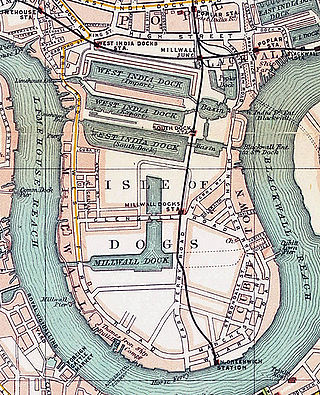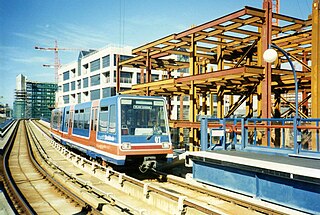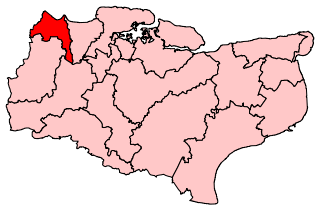Related Research Articles

London Docklands is the riverfront and former docks in London. It is located in inner east and southeast London, in the boroughs of Southwark, Tower Hamlets, Lewisham, Newham, and Greenwich. The docks were formerly part of the Port of London, at one time the world's largest port. After the docks closed, the area had become derelict and poverty-ridden by the 1980s. The Docklands' regeneration began later that decade; it has been redeveloped principally for commercial and residential use. The name "London Docklands" was used for the first time in a government report on redevelopment plans in 1971 and has since been almost universally adopted. The redevelopment created wealth, but also led to some conflict between the new and old communities in the area.

Lewisham is a London borough in south-east London; it forms part of Inner London. The principal settlement of the borough is Lewisham. The local authority is Lewisham London Borough Council, based in Catford. The Prime Meridian passes through Lewisham. Blackheath, Goldsmiths, University of London and Millwall F.C. are located within the borough.

Bracknell Forest is a unitary authority area in Berkshire, southern England. It covers the two towns of Bracknell and Sandhurst and the village of Crowthorne and also includes the areas of North Ascot, Warfield and Winkfield. The borough borders Wokingham and the Royal Borough of Windsor & Maidenhead in Berkshire, and also parts of Surrey and Hampshire.

Woolwich Arsenal station is a National Rail and Docklands Light Railway (DLR) paired interchange station in the heart of Woolwich in the Royal Borough of Greenwich. It has two parts; its raised, south-western part of the station is on the semi-slow, commuter service, corollary of the North Kent Line and also in its Dartford Loop services section between London and Dartford, run by Southeastern. Regular services beyond Dartford are to the Medway Towns, which start/finish in the opposite direction at Luton via the City of London, West Hampstead and St Albans. Its other part is the terminus of its own branch of the DLR, run by Transport for London.

Lewisham is an area of southeast London, England, 5.9 miles (9.5 km) south of Charing Cross. It is the principal area of the London Borough of Lewisham, and was within the historic county of Kent until 1889. It is identified in the London Plan as one of 35 major centres in Greater London, with a large shopping centre and street market.

The Woolwich Ferry is a free vehicle and pedestrian ferry across the River Thames in East London, connecting Woolwich on the south bank with North Woolwich on the north. It is licensed and financed by London River Services, the maritime arm of Transport for London (TfL). Around two million passengers use the ferry each year.

The London Docklands Development Corporation (LDDC) was a quango agency set up by the UK Government in 1981 to regenerate the depressed Docklands area of east London. During its seventeen-year existence it was responsible for regenerating an area of 8.5 square miles (22 km2) in the London Boroughs of Newham, Tower Hamlets and Southwark. LDDC helped to create Canary Wharf, Surrey Quays shopping centre, London City Airport, ExCeL Exhibition Centre, London Arena and the Docklands Light Railway, bringing more than 120,000 new jobs to the Docklands and making the area highly sought after for housing. Although initially fiercely resisted by local councils and residents, today it is generally regarded as having been a success and is now used as an exemplar of large-scale regeneration, although tensions between older and more recent residents remain.

The Thames Gateway Bridge was a proposed crossing over the River Thames in east London, England. It was first mooted in the 1970s but never came to fruition. The concept was re-proposed in 2004, with preliminary planning proceeding until November 2008, when Boris Johnson, the then Mayor of London, formally cancelled the entire £500 million scheme.

Beckton is a suburb in east London, England, located 8 miles (12.9 km) east of Charing Cross and part of the London Borough of Newham. Adjacent to the River Thames, the area consisted of unpopulated marshland known as the East Ham Levels in the parishes of Barking, East Ham, West Ham and Woolwich. The development of major industrial infrastructure in the 19th century to support the growing metropolis of London caused an increase in population with housing built in the area for workers of the Beckton Gas Works and Beckton Sewage Treatment Works. The area has a convoluted local government history and has formed part of Greater London since 1965. Between 1981 and 1995 it was within the London Docklands Development Corporation area, which caused the population to increase as new homes were built and the Docklands Light Railway was constructed.

Dartford is the principal town in the Borough of Dartford, Kent, England. It is located 18 miles south-east of Central London and is situated adjacent to the London Borough of Bexley to its west. To its north, across the Thames estuary, is Thurrock in Essex, which can be reached via the Dartford Crossing.

Sevenoaks is a constituency represented in the House of Commons of the UK Parliament since 2019 by Laura Trott, a Conservative.

Dartford is a constituency represented in the House of Commons of the UK Parliament since 2010 by Gareth Johnson of the Conservative Party. It is currently the longest-valid 'bellwether' constituency in the country as the party of the winning candidate has gone on to form the government at every UK general election since 1964. Candidates for the largest two parties nationally have polled first and second since 1923 in Dartford.

Columbus Tower was a planned high-rise development by Commercial Estates Group approved for construction on a site on the Isle of Dogs, London Borough of Tower Hamlets. The 63-storey, 242 m (794 ft) AOD tower would have been located on a 0.36-hectare site at the western end of the north dock at West India Quay. At 2009 projected cost was £450M to build and reaching 237 metres in height, and projected was taller only by 2 m than One Canada Square.
The Lower Thames Crossing is a proposed road crossing of the Thames estuary downstream of the Dartford Crossing that links the counties of Kent and Essex, and its proposed approaches. If built it would pass through the districts of Thurrock and Gravesham, supplementing the Dartford route. The approximately 14.3-mile (23.0 km) route will be assessed by the Planning Inspectorate.

Rainham is a suburb of East London, England, in the London Borough of Havering. Historically an ancient parish in the county of Essex, Rainham is 13.6 miles (21.9 km) east of Charing Cross and is surrounded by a residential area, which has grown from the historic village, to the north and a commercial area, fronting the River Thames, to the south. As part of the suburban growth of London in the 20th century, Rainham significantly expanded and increased in population, becoming part of Hornchurch Urban District in 1934, and has formed part of Greater London since 1965. The economic history of Rainham is underpinned by a shift from agriculture to industry and manufacture and is now in a period of regeneration, coming within the London Riverside section of the Thames Gateway redevelopment area.
A heritage asset is an item that has value because of its contribution to a nation’s society, knowledge and/or culture. They are usually physical assets, but some countries also use the term in relation to intangible social and spiritual inheritance. The term is found in several contexts:

The London Resort is a proposed theme park and resort in Swanscombe, Kent. The project was first announced on 8 October 2012; however, it has been subject to numerous delays since then, and the examination of its application for planning permission has been subject to considerable delay. Eventually, a decision will be made by the Secretary of State.
Alan Alexander is a Scottish academic, writer and public servant. He was General Secretary of the Royal Society of Edinburgh 2013 -2018.

Urban planning, also known as town planning, city planning, regional planning, or rural planning, is a technical and political process that is focused on the development and design of land use and the built environment, including air, water, and the infrastructure passing into and out of urban areas, such as transportation, communications, and distribution networks and their accessibility. Traditionally, urban planning followed a top-down approach in master planning the physical layout of human settlements. The primary concern was the public welfare, which included considerations of efficiency, sanitation, protection and use of the environment, as well as effects of the master plans on the social and economic activities. Over time, urban planning has adopted a focus on the social and environmental bottom-lines that focus on planning as a tool to improve the health and well-being of people while maintaining sustainability standards. Sustainable development was added as one of the main goals of all planning endeavors in the late 20th century when the detrimental economic and the environmental impacts of the previous models of planning had become apparent. Similarly, in the early 21st century, Jane Jacob's writings on legal and political perspectives to emphasize the interests of residents, businesses and communities effectively influenced urban planners to take into broader consideration of resident experiences and needs while planning.
Francis Raymond "Frank" Baker, is a British diplomat and civil servant who was Ambassador to Libya from February 2018 to April 2019. He was Ambassador to Kuwait from 2010 to 2014, and Ambassador to Iraq from 2014 to 2017.
References
- ↑ "House of Commons – HC 1526 Communities and Local Government Committee: Written evidence from Adrian Penfold". Parliament of the United Kingdom. Retrieved 25 March 2015.
- 1 2 3 4 5 6 7 8 9 10 "Adrian Penfold, Esq Authorised Biography – Debrett's People of Today". Debretts. Archived from the original on 5 July 2015. Retrieved 25 March 2015.
- ↑ "Penfold Review: Non-planning consents must be simplified". Architects Journal. 7 July 2010. Retrieved 25 March 2015.
- 1 2 3 4 5 6 7 8 "Twenty eminent planners". Planning Resource. Retrieved 25 March 2015.
- ↑ "Q&A with Adrian Penfold – British Land". British Land. Retrieved 25 March 2015.
- ↑ "DBIS Penfold review of 'non-planning' consents: includes LBC". ihbconline.co.uk. Retrieved 25 March 2015.
- ↑ "An interview with Adrian Penfold". mola.org.uk. Retrieved 25 March 2015.
- ↑ Ricketts, Simon; Field, Duncan (January 2012). Localism and Planning. ISBN 9781847669452 . Retrieved 25 March 2015.
- 1 2 3 PENFOLD - Review of non-planning consents, Final Report, July 2010, URN 10/1027
- ↑ Department for Business Innovation & Skills, GOVERNMENT RESPONSE TO THE PENFOLD REVIEW OF NON-PLANNING CONSENTS, 3 November 2010
- ↑ "Hands Off Our Land: ministers' areas 'sitting ducks' for builders". The Daily Telegraph. 15 September 2011. Retrieved 25 March 2015.
- ↑ "Queen's birthday honours list 2015: OBE". The Guardian. 12 June 2015. Retrieved 21 September 2015.